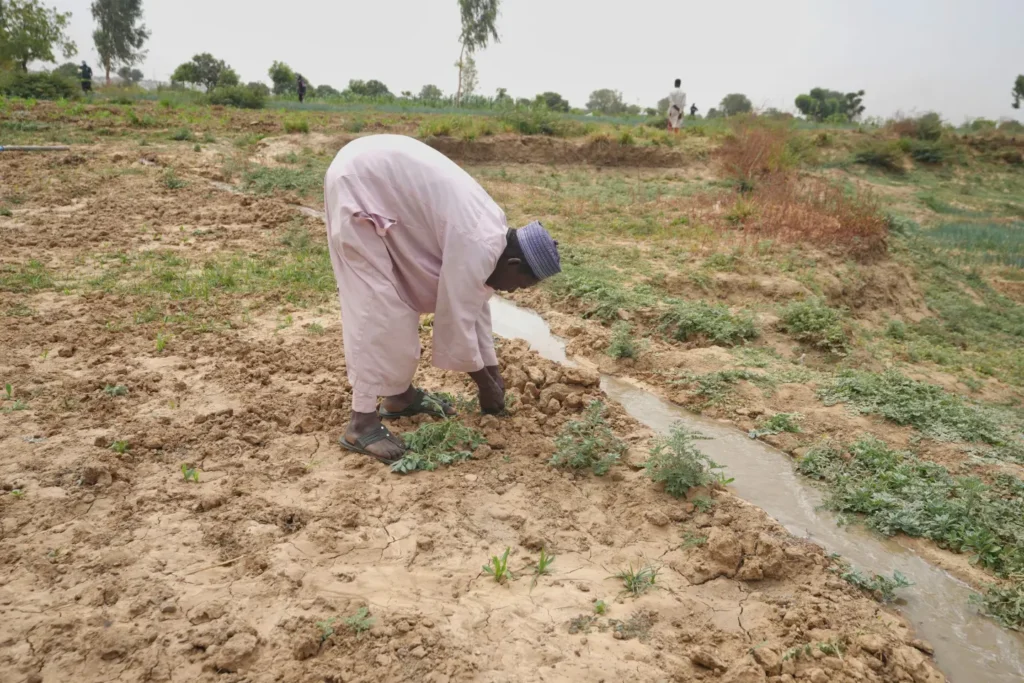Nigeria’s Silent Struggle: How Climate Change Is Drying Up Farms and Futures in the North
In the quiet, rural village of Kwalkwalawa in Sokoto State, northwestern Nigeria, 62-year-old Umaru Muazu surveys his parched farmland. After more than two decades of growing millet and maize, what’s left is a cracked field and a murky puddle—the remnants of a once-reliable river.
“I used to harvest much from just a small piece of land,” he says with a wistful tone. Now, without the funds to dig a well or irrigate his 5-hectare farm, Muazu is contemplating giving up farming altogether.
This is not just his story—it’s the story of millions of smallholder farmers across Nigeria. As climate change accelerates, it’s rewriting the rules of farming in Africa’s most populous nation, where over 80% of farmers rely on seasonal rainfall and simple tools to feed their communities.
Climate Shocks Are No Longer Occasional — They’re Constant
Long dry spells, rising temperatures, and shorter rainy seasons are pushing water sources to the brink. In a country where 31 million people already face food insecurity, according to the World Food Program (WFP), the threat to agriculture is becoming more dire with each passing season.
“The moment one climate shock ends, another begins,” notes Chi Lael, WFP spokesperson. The impact is especially severe in the northern regions—where much of Nigeria’s food is grown—and the ripple effect reaches the bustling southern markets in cities like Lagos.
A Nation Dependent on Fragile Farmlands
Despite government promises, infrastructure to support climate resilience—like dams, irrigation systems, and farmer education—remains limited. The result: low yields, drying rivers, and vanishing hope.
“In Adamawa State alone, over 1,250 hectares of farmland have been affected by water scarcity,” reports Nigeria’s National Emergency Management Agency. And across Sokoto, stories like Muazu’s are common.
Nasiru Bello, another farmer, is trying to grow onions. With wells and rivers drying up, he’s now forced to pump groundwater, a costly endeavor in an era of rising fuel prices. “The plants just don’t grow the way they used to,” he laments.
Climate Change Isn’t the Only Culprit
Experts point out that deforestation and over-extraction of groundwater are worsening the crisis. “Two-thirds of the trees in Sokoto State have disappeared,” says Yusuf Isah Sokoto, director at Umaru Ali Shinkafi Polytechnic’s College of Environmental Science. “That loss contributes significantly to rising local temperatures.”
And yet, amid all this, there’s a growing push for climate-smart agriculture—an approach that blends traditional knowledge with modern technology. Techniques like drip irrigation, which delivers water directly to the roots of crops, are being promoted by organizations like the UN Food and Agriculture Organization (FAO) to help farmers conserve precious resources.
“There should be more education and orientation for farmers about climate change,” Yusuf urges.
Food Prices Rising, Yields Falling
The cracks in the farming system are being felt across the country. In Lagos, the price of northern-grown produce has skyrocketed. A head of cabbage, for instance, now sells for ₦2,000 ($1.20)—nearly double what it cost a year ago, and over five times the price in Sokoto.
According to the National Bureau of Statistics, agriculture contributed 22% of Nigeria’s GDP in Q2 of 2024—down from 25% the previous quarter. Meanwhile, household food imports rose by 136% between 2023 and 2024, reflecting a growing dependence on foreign food sources.
Government Promises vs. Ground Realities
In May 2023, President Bola Tinubu declared a state of emergency on food security and unveiled plans to activate 500,000 hectares of farmland from Nigeria’s land banks—most of which are located in the north. But one year later, these land banks remain untouched.
“Farmers who used to harvest 10 tons are now lucky to get even half,” admitted Agriculture Minister Aliyu Abdullahi earlier this year.
The urgency is underscored by Nigeria’s rapidly growing population. By 2025, Nigeria is expected to become the third most populous country in the world, behind India and China. By 2050, that number could reach 400 million.
A Call for Action and Hope
The situation is daunting, but it’s not hopeless.
Local nonprofits like Extension Africa, which support farmers with practical climate solutions, are stepping in where official support is lagging. More young innovators and communities are rising to the challenge, experimenting with new farming techniques and planting trees to fight erosion and heat.
Still, much more is needed—from government, the private sector, and international partners—to equip farmers like Umaru Muazu with the tools and infrastructure to adapt, survive, and thrive.
Because when Nigeria’s farmers struggle, the entire nation feels it.
Sourses: https://apnews.com/

